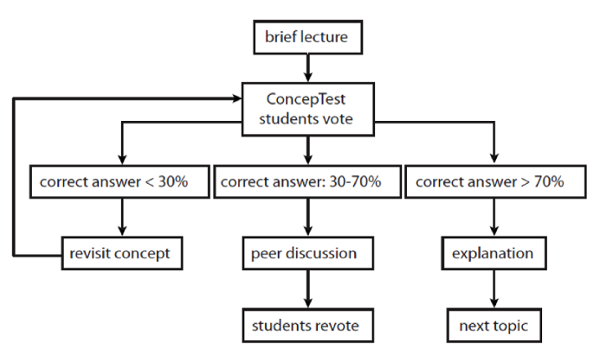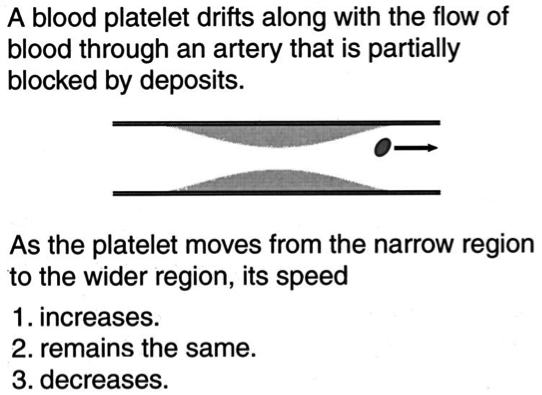Peer instruction
The peer instruction envisioned in this article is a teaching strategy where two or three students discuss and explain their thinking. The goal of the discussion is deeper understanding of the concept being discussed, so students are much more likely to recall and use the concept later in the course, in future courses, and in their career. The act of explaining and defending one’s understanding against the alternative explanations of others helps students engage deeply with the concept, refining their mental model of it. By contrast, superficial learning consists of memorizing information, storing it in the “school” compartment of one’s mind, with little spillover effect into the more important areas of life having to do with real understanding of how the world works, or changing behaviour.
Peer instruction has been shown repeatedly from research to improve students’ conceptual reasoning and quantitative problem solving ability (Crouch and Mazur, 970; Fagan, Crouch, Mazur, 206, 207; Lasry, Mazur, Watkins, 1066). It has also been shown to reduce course attrition (Lasry, Mazur, Watkins, 1066).
A specific method and tips on its successful use are explained below. I thought it best to give the details of the specific method and the rationale to enable better informed choices of what parts to use in your situation.
Peer instruction methods
During the lecture:
Lecture for 5-10 minutes, then use a quiz question to get students to apply the new knowledge. The answer option distractors should be based on common misconceptions. Have students vote on the correct answer. This can be done by show of hands, coloured cards with a colour for each answer option, or clickers. What happens next depends on the aggregate student response (see flow chart, below).

What you are looking for in the student response is enough students with the correct answer to make peer instruction worthwhile, rather than it being a sharing of ignorance.
If less than 30% have the correct answer, that’s the signal to lecture more on the topic, perhaps with different examples and illustrations.
If more than 70% have the correct answer, then you can reiterate the explanation of the correct answer and move on to the next topic.
If, however the percentage of correct answers is in the 50% range, then have students explain to their neighbour (or neighbours—groups of 2 or 3) which answer they picked and why, then listen as their neighbour does the same. If their answers differ, they should try to convince each other of the correctness of their answer by explaining the underlying reasoning. The instructor should circulate to hear explanations to get clues on how to address misconceptions, and also to encourage students to participate. The discussion typically lasts 2-4 minutes.
The instructor then ends the discussion and re-polls students on the question. If enough answers have changed so that 70% have selected the correct answer, then explain the correct answer and move on to the next topic lecture segment. If enough students have not changed their answers, then re-explain (using some of the discussion conversation you have heard if appropriate) and use a different quiz question on the same topic.

A sample concept application quiz question with misconceptions in the answer options.
Before the lecture:
Again, these are the parts of this method that have given the improved student performance cited in the research, so you can make fully informed choices on how to implement peer instruction, not recommendations on what you should do.
Assign a reading to be completed before the lecture. The Harvard practitioners gave readings from a textbook designed for pre-lecture, not post-lecture reading.
Have students complete a 3-question free response online test on the reading. The first two questions provoke thought on difficult aspects in the reading. The third asks, ‘‘What did you find difficult or confusing about the reading? If nothing was difficult or confusing, tell us what you found most interesting. Please be as specific as possible.’’
Prior to class, the instructor reads the quiz responses, and uses answers to the third question as a guide to which topics to cover in class. Since the peer instruction method takes class time to be effective, topic coverage is focused mostly on those topics students struggle with.
The lecture is planned in roughly 10-minute segments.
Quiz questions for each segment (preferably 2 for each) are created or found and refined.
Considerations
In the Harvard method, students are not graded on their answers to the in-class quiz questions, but do receive a mark out of 5 for consistent participation. Also, the fact that midterm and final exam questions are made up of a significant percentage of in-class quiz concept questions acts as an incentive to participate.
To free up class time for ConcepTests, and to prepare students better to apply the material during class, students are required to complete the reading on the topics to be covered before class. Learning from reading is a skill well worth developing, particularly because after college a great deal of ongoing learning takes place through reading. To help students identify and grasp the key points of the reading, as well as to provide an incentive for students to actually complete the reading, we give students credit for answering a few questions designed to help them think about the material.
Students receive credit for online quiz completion based on effort rather than correct answers, which greatly reduces the grading effort required while still providing good lecture planning information. Students respond particularly positively to reading assignments when their questions are answered in class or by answers to FAQs posted on the course Web site.
Challenges
These challenges were reported in a survey of hundreds of professors using peer instruction in a variety of disciplines (Fagan, Crouch & Mazur):
| Challenge | Strategies |
|---|---|
| It takes considerable time and effort to develop effective concept quiz questions (selecting key aspects of a topic and creating application-level questions with distractors based on common misconceptions). | This IS time consuming. Textbook publisher test bank questions aren’t crafted in this format. Better to start with enough questions to do some peer instruction and build up a bank of concept questions over a few years. Or work with colleagues and share questions. |
| Colleagues may be skeptical of the benefit of student discussions that take away from lecture time. | Show them the research evidence that peer instruction works. Invite them to sit in on a class where the technique is being used effectively. Share positive student feedback with them. Offer the assessment tests to colleagues. Generate your own success statistics over time. |
| The required quantity of material to cover makes it difficult to devote class time to peer instruction. | Its better that students be able to apply major concepts than that all the content be presented in class. Focus on the things students struggle with. No need to teach the concepts they get from the readings or already know. |
| Students may put up resistance. Many students are new to active class participation. Some feel uncomfortable participating in discussions, or think discussions are a waste of time. | Show students they are your partners in education, not pupils upon whom your opaque expert teaching techniques are administered. Explain the rationale, show them the research-based evidence to support improved student learning outcomes that come from the use of peer instruction. Persistence in use of this method is important—things get better over time. |
| Difficulty in getting all students to participate. | It is important for the instructor to circulate through the classroom during the group discussion, helping to guide and encourage students in discussion. Points and reiterating the rationale and evidence help. |
References
Crouch, C. H. & Mazur, E. (2001). Peer Instruction: Ten years of experience and results. American Association of Physics Teachers, 69(9).
Fagen, A. P., Crouch, C. H. & Mazur, E. (2002). Peer Instruction: Results from a Range of Classrooms. The Physics Teacher, 40(April).
Lasry, N., Mazur, E. & Watkins, J. (2008). Peer instruction: From Harvard to the two-year college. American Association of Physics Teachers, 76(11).
